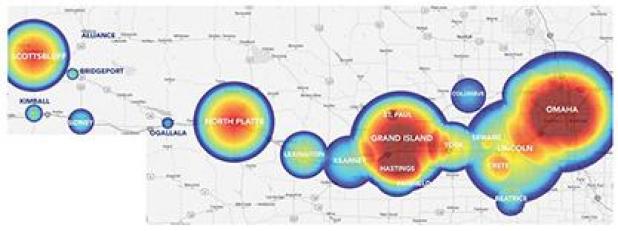
Heider College of Business Creighton University
A 2016 study using now shutdown site backpage.com illustrates that commercial sex advertising reached nearly every town and city along I-80. Advertising in western Nebraska extends out to Sidney, Kimball and Bridgeport. In the central part of the state, Lexington and Hastings stand out.
Sex trafficking not far from home
Sex trafficking is closer to home than many might like to believe.
Every 30 seconds, another person becomes a victim of human trafficking.
Labeled as modern-day slavery, human trafficking involves the use of force, fraud, or coercion to obtain some type of labor or commercial sex act.
Two human trafficking specialists from North Platte delivered a presentation to Grant Rotarians last week on sex trafficking in Nebraska.
Tanya Roberts-Connick, chief deputy county attorney in Lincoln County, leads the western region of the Nebraska Human Trafficking Task Force, which is based out of the Nebraska Attorney General’s Office.
LeeAnn Neilsen is the human trafficking specialist for the Salvation Army’s Fight to End Trafficking (SAFE-T) in North Platte. She serves 34 counties in western Nebraska.
Neilsen said the task force goals are to recover victims, reduce the market and stop traffickers.
“So basically, by recovering victims, and arresting those who are buying commercial sex, we’re hoping to stop those who are trafficking individuals,” she said.
Sex trafficking, unlike prostitution, is not voluntary or consensual. It can happen to all ages and genders. Neilsen noted girls ages 14-17 are the most popular in Nebraska, in terms of what buyers in the market look for.
She said she’s worked with individuals up to age 50 who have been victims of trafficking, but they are usually “kicked to the curb,” so to speak, in their late 20s.
Stopping a growing industry
Human trafficking is generating $1 billion a year, and quickly growing, second only to drug trafficking.
Once drugs are sold, they’re gone. Traffickers can sell their victims over and over again, and the risk of getting caught is much lower.
The primary hub for buying and selling takes place online.
Neilsen said their “John Operations” have been the most successful, which involve setting up fake profiles of girls advertising themselves.
While they have had success busting buyers (Johns), Roberts-Connick said recovering the victims is difficult because many of them refuse help. This can be due to a variety of reasons, including being scared of, in love with or brainwashed by their “pimps.”
On April 11, President Donald Trump signed SESTA/FOSTA into law, which shutdown websites sollwing commercial sex. SESTA stands for Stop Enabling Sex Traffickers Act and FOSTA stands for Allow States and Victims to Fight Online Sex Trafficking Act.
Neilsen said while that’s a wonderful thing, it has negatively affected the teams trying to recover victims by using those sites.
Traffickers and victims
Traffickers operate on power and control. They prey on vulnerabilities such as bad home lives, poverty, substance abuse, poor mental health, developmental delays and others.
If victims are not already addicts, traffickers will often make them addicts to gain more control.
To read the full story, subscribe to the e-edition online or call the Breeze at 308-394-5389 to subscribe to the print edition
